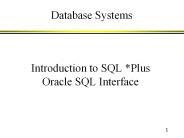Introduction to Oracle and SQL - PowerPoint PPT Presentation
1 / 16
Title:
Introduction to Oracle and SQL
Description:
Support for On Line Transaction processing (OLTP) 3 ... Bandwagon effect cf. IBM. How important is the information? Insurance/banks have a keen interest ... – PowerPoint PPT presentation
Number of Views:126
Avg rating:3.0/5.0
Title: Introduction to Oracle and SQL
1
Introduction to Oracle and SQL
- Contact Details
- Janet Francis
- www.staffs.ac.uk/jsf1
- j.francis_at_staffs.ac.uk
- (01785) 353467 (working hours)
- Room K319
2
Oracle
- What is it
- Relational Database Management System (RDBMS)
- Support for On Line Transaction processing (OLTP)
3
Oracle Information and Help
4
Oracle Documentation
- Useful Oracle documentation
- Oracle9i App. Developers Guide Oracle9i
Server Concepts manual - SQL Reference SQLPlus User Guide
- PL/SQL Users Guide Performance Tuning
- Guide and Reference
- System Release Bulletins
- Support CDs
- Support Alerts
- Journals and Magazines
- Oracle Texts
- - Oracle9i the Complete Reference
- - Oracle for Beginners
- - SQL for Dummies
5
- Information and Help
- Web sites
- - www.ioug.org
- - govt.us.oracle.com
- - otn.oracle.com (Oracle Technology
Network OTN) - - www.eoug.com
- - www.ukoug.org
- - www.lazydba.com
- List servers - ORACLE-L
- - dwlist_at_datawarehousing.com
- Oracle Support - Metalink
- - System based on local calls to
regional centres
6
- Oracle and SQL
- Oracle is a Relational Database Management
System (RDBMS) - - Has a variety of associated tools and
applications - Developer 6i (Forms and Reports) Designer 6i
- Express (OLAP) products Applications products
- Java Development tools
(JDeveloper) Application (Web) Servers - Portal Wireless and Mobile
- Uses SQL to manipulate data
- - SQL is used to
- Retrieve data
- Update, insert, delete data
- Control transactions
- Define database structures
- Maintain security
- - SQL is the only way into Oracle data
7
Client/Server Architecture
Database Server (UNIX/NT)
Oracle Net
PC/Workstation Client
Oracle Net
Network TCP/IP protocol
Oracle RDBMS
Oracle or 3rd party Development Tool
8
3-Tier Architecture
Database Server (UNIX/NT)
Application Server (UNIX/NT)
Oracle Net
Thin Client (or PC/Workstation)
Oracle Net
Network link
Network TCP/IP protocol
Oracle RDBMS
Oracle Application Server
Browser
9
Relational Database Model
- Advantages
- More flexible
- Relationships implemented by content address
- More controlled redundancy
- Disadvantage
- Slow?
10
Dept and Emp!
- What are they?
- What are they used for?
11
- EMP DEPT tables
DEPTNO DNAME LOC ------ --------------
-------- 10 ACCOUNTING NEW YORK 20
RESEARCH DALLAS 30 SALES
CHICAGO 40 OPERATIONS BOSTON
DEPT Table
EMP Table
EMPNO ENAME JOB MGR HIREDATE SAL
COMM DEPTNO ----- -------- --------- -----
--------- ----- ----- ------ 7369 SMITH CLERK
7902 17-DEC-80 800 20 7499
ALLEN SALESMAN 7698 20-FEB-81 1600 300
30 7521 WARD SALESMAN 7698 22-FEB-81
1250 500 30 7566 JONES MANAGER 7839
02-APR-81 2975 20 7654 MARTIN
SALESMAN 7698 28-SEP-81 1250 1400 30
7698 BLAKE MANAGER 7839 01-MAY-81 2850
30 7782 CLARK MANAGER 7839 09-JUN-81
2450 10 7788 SCOTT ANALYST 7566
09-DEC-82 3000 20 7839 KING
PRESIDENT 17-NOV-81 5000 10
7844 TURNER SALESMAN 7698 08-SEP-81 1500
0 30 7876 ADAMS CLERK 7788 12-JAN-83
1100 20 7900 JAMES CLERK 7698
03-DEC-81 950 30 7902 FORD
ANALYST 7566 03-DEC-81 3000 20
7934 MILLER CLERK 7782 23-JAN-82 1300
10
12
OLTP Database
- Performs the basic business functions of the
enterprise - Via online or batch processing
- Objective is to process transactions in timely
fashion and - ensure validity of data
- Performs a mix of read/write processing
- Creating (inserting), reading, updating,
deleting data - Must also provide
- Concurrency control
- Usually via locking and/or timestamping
- Support for transaction design and control
- Security and Integrity
- Backup and recovery
13
Decision Support Database/Warehouse
- Provides results for querying, reporting,
- Online Analytical processing
- Essentially read only
- Produces output to complex queries in timely
fashion - Requires a range of tools or customised
applications - Tools must be user-friendly and intuitive
- Make full use of a business data model
- Tend to be huge with some very large tables
- Oracle9i can support up to 512 petabytes of
data
14
- Advantages of the Database Approach
- Centralised control
- Enforcement of standards
- Data is highlighted as a valuable resource
- Standardisation of security and integrity e.g.
backup - Balancing requirements DBA
- Management has better visibility all data in
one place - More integrated processing fewer programs
- Controlled (reduced) redundancy of data
- Reduced inconsistencies
- More sophisticated validation
- Data Independence (Program/Data Independence)
- Reduced program maintenance
- Physical data independence
- Protection from changes in hardware etc.
- Logical data independence
- Protection from changes to schema (data model)
15
Disadvantages of the Database Approach
- Cost of initial conversion - purchase
- - installation
- - training
- - new applications
- - data entry
- Operating costs may be higher - DBMSs are
resource hungry - e.g. 60 of code in IMS is
concerned with security - Success may be its own undoing - easy access
----------gt - performance degradation
- Reduced redundancy - all eggs in one basket
- Politics - naming conventions
- Some Comments
- Bandwagon effect cf. IBM
- How important is the information?
- Insurance/banks have a keen interest
16
People Issues
- Motivating staff to maintain old systems
- Migration and the complexities involved
- Organisation priorities ever changing and
interrupting plans - Recruitment people with Oracle experience are
rare - Staff have increasing value on job market as they
are trained - User support many extra skills needed
- User access new tools need new thinking and new
controls - Disciplines standards, methodologies, QA etc.
- Technical support high reliance on a few
individuals - Getting the right mix of job content































